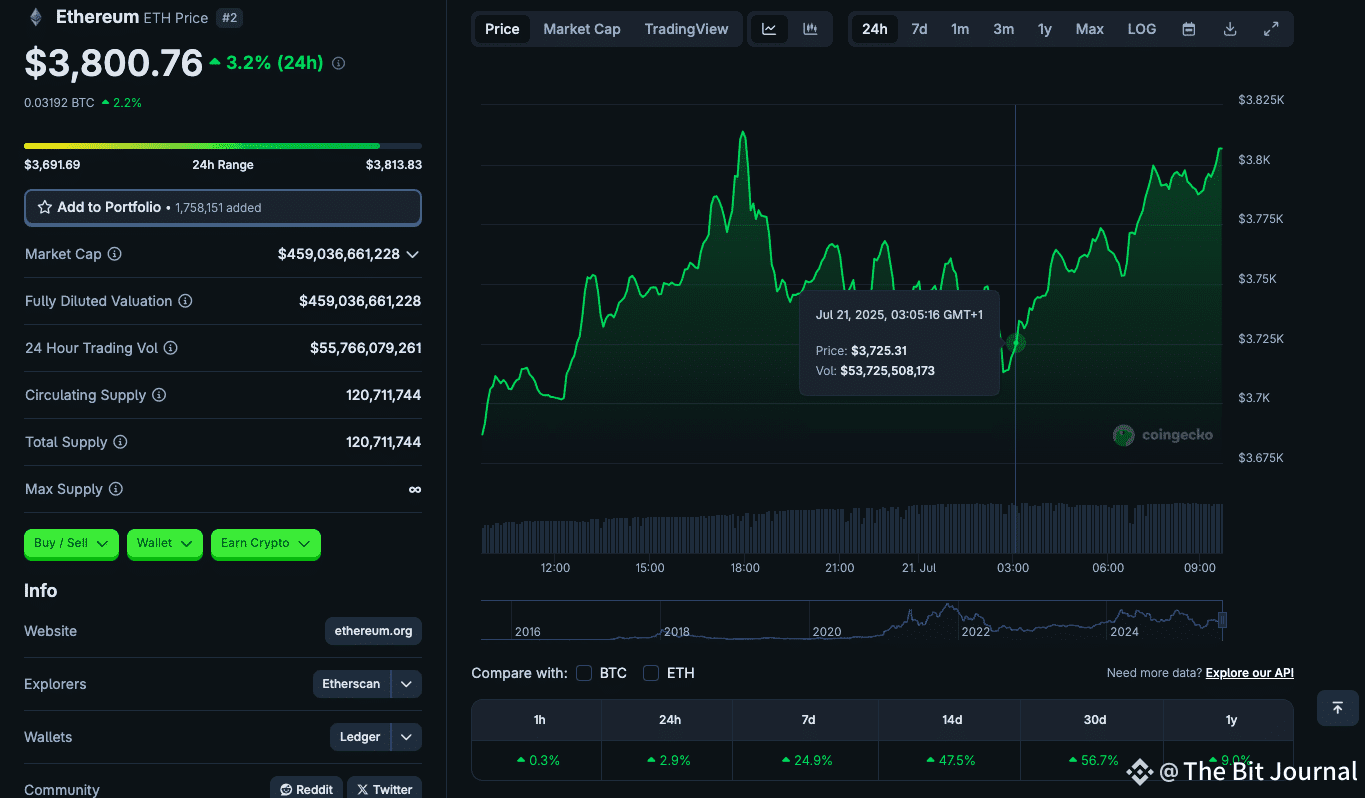Ethereum scaling just took a notable step forward. The network’s gas limit went above 37.3 million, with nearly half of validators backing a jump to increase to 45 million units, giving room to more transactions and lower fees.
This comes as Ethereum outperforms Bitcoin, four weeks in a row, adding to the altcoin market cap of 41%. Experts say the combination of better infrastructure and renewed interest in Ethereum may be lighting the fuse on an “altseason.”
Validators Pump the Gas
According to Etherscan, Ethereum’s gas limit is now 37.3 million, up 3% in just a few days; the first of such increase since February. Validators can increase the block gas limit by about 0.1% per block and a grassroots “pump the gas” campaign now has 47.2% of staked validators voting for 45 million.
Vitalik Buterin confirmed:
“Almost exactly 50% of stake are voting to increase the L1 gas limit to 45 million.”
He also noted that recent node client updates; especially Geth, make larger blocks safer due to improved archive node handling.
Transactions Up, Fees Down
Higher gas limits improve Ethereum scaling, allowing more transactions per block. Chainspect data shows the network is now at nearly 18 TPS, up from 15 TPS before the last increase. Daily transactions have gone from 1.1 million in April to 1.4 million. More capacity means less congestion, lower fees and a better user experience.
Price Action: ETH Breaks Out, Altcoins Rally
Ethereum’s network growth is reflected in the price. ETH is up 54% in the last month, above $3,800 with ETF inflows and corporate treasury adoption. On-chain, the ETH/BTC pair has logged consecutive growth for four weeks in a row, moving to 0.03153, while Bitcoin’s dominance is down to 61.05%, the lowest in two months.
 Ethereum Price Action
Ethereum Price Action
This capital rotation is in line with broader altcoin sentiment: TOTAL2 (market cap of all cryptos excluding Bitcoin) went from $1.06 trillion in June to $1.5 trillion, a 41% increase. CoinGlass’s altcoin season index is above 50, indicating altseason might just be here.
Ethereum Scaling: Technical and Fundamental Drivers
Looking at Infrastructure, Gas limit increases are validator-driven, leading to lower fees and more scalability. Node software updates (like Geth) make larger blocks safer.
For Ethereum Network, the daily transactions are over 1.4 million and TPS is at multi-month highs near 18, up from 15 pre-increase.
As regards the Price, ETH/BTC strength now, indicates that investors are buying higher-beta assets. Rising altcoin market cap means liquidity is flowing into decentralized ecosystems.
What This Means for Investors
Ethereum scaling progress, both on-chain and price-driven, means the network is moving beyond old constraints. Lower congestion, lower gas fees and better validator support makes Ethereum more competitive. Calling this an official “altseason” may be too early but current trends look strong.
For what to watch, the first is the Validator Signal Rates. Will 45M gas units get 50% support for a safe limit increase? For the average gas fees, lower fees means more usage. Can other Layer‑1 or Layer‑2 tokens follow Ethereum? Continued ETF inflows or macro liquidity triggers could boost altcoin gains.
Conclusion
Based on the latest research, Ethereum scaling is entering the final phase. Validator support for higher gas limits, rising TPS and better transaction metrics all means the network is more capable and usable. Price action (ETH breaking above BTC) reflects this technical progress and is fueling an altcoin rally.
These are the early days in the cycle but the combination of infrastructure upgrades and market rotation means Ethereum may lead the next altseason if these upgrades go smoothly and macro factors are supportive.
For in-depth analysis and the latest trends in the crypto space, our team offers expert content regularly.
Summary
Ethereum scaling is real. Validators have raised gas limits above 37M, towards 45M, and market is seeing 18 transactions per second and congestion reduction. This technical progress supports the price rally; up 54% in a month, and ETH is now up four weeks in a row as against BTC. Capital is clearly rotating into altcoins, 41% increase in non-BTC market cap and altseason index above 50.
FAQs
What does increasing the gas limit mean?
More gas per block means more transactions, less queuing and fees. Validators agreed to test 45 million from over 37 million.
How does Ethereum scaling affect gas fees?
More capacity means less competition for block space. If demand stays the same, fees go down or stabilize.
What does TPS stand for?
Transactions Per Second, a measure of network throughput. Ethereum’s TPS went to 18 after the limit increase.
Is altseason happening now?
ETH outperforming BTC for four weeks in a row, altcoin cap up 41% and altseason season index is above 50. Experts say it’s early altseason.
What should investors watch?
Validator consensus on gas limits, daily transaction count, average gas fees and altcoin performance vs ETH.
Glossary
Gas Limit: Maximum computational effort per block.
Transactions Per Second (TPS): Average transactions per second.
Altseason: When altcoin prices outperform Bitcoin.
ETH/BTC Pair: Ethereum price relative to Bitcoin.
Total Market Cap of Altcoins (TOTAL2): All non-BTC cryptocurrency market cap.
Validator: Node that proposes and validates new blocks on Ethereum.
Sources
Etherscan
CoinGecko
Ambcrypto
Cointelegraph
Read More: Ethereum Just Took a Major Step Toward Scaling: Is This the Spark for Altseason?">Ethereum Just Took a Major Step Toward Scaling: Is This the Spark for Altseason?


